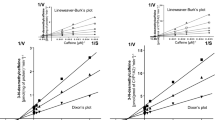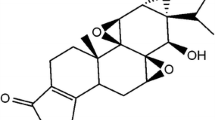Abstract
Objective
Our aim was to correlate the in vitro and in vivo CYP1A2 inhibition potential of tolfenamic acid, an NSAID highly (99.7%) bound to plasma proteins, to study the significance of protein binding of inhibitor in metabolic drug interactions.
Methods
The effect of tolfenamic acid on CYP1A2 (phenacetin O-deethylation) was studied using human liver microsomes, with and without albumin (0–10 mg/ml). In a randomized, crossover study, 10 volunteers took 200 mg tolfenamic acid or placebo t.i.d. for 3 days. On day 2, a caffeine test was performed. On day 3, each ingested 4 mg of the CYP1A2 substrate tizanidine. Plasma tizanidine, its metabolites (M) and tolfenamic acid, and pharmacodynamic variables were measured.
Results
Tolfenamic acid strongly inhibited phenacetin-O-deethylation in vitro (IC50 1.8 μM without albumin). Albumin decreased its inhibitory effect in a concentration-dependent manner; the IC50 exceeded 100 μM with 10 mg/ml of albumin. Tolfenamic acid had no effect on the area under the concentration-time curve \({\left( {{\text{AUC}}_{{0 - \infty }} } \right)}\), peak concentration, time of peak concentration or half-life of tizanidine or M-3; only the \({\text{AUC}}_{{0 - \infty }} \) of secondary metabolite M-4 was slightly decreased (13%, P = 0.004). The caffeine test and the pharmacodynamic effects of tizanidine were unchanged.
Conclusions
Tolfenamic acid potently inhibits CYP1A2 in vitro when studied without albumin, but not in vivo. This apparent discrepancy is due to the high protein binding of tolfenamic acid. To avoid overestimation of the interaction potential, the inhibitory effect of highly albumin-bound compounds should also be studied in vitro with albumin, or their exact unbound plasma concentration should be used in predictions.


Similar content being viewed by others
References
Backman JT, Karjalainen MJ, Neuvonen M, Laitila J, Neuvonen PJ (2006) Rofecoxib is a potent inhibitor of cytochrome P450 1A2: studies with tizanidine and caffeine in healthy subjects. Br J Clin Pharmacol 62:345–357
Bjornsson TD, Callaghan JT, Einolf HJ, Fischer V, Gan L, Grimm S, Kao J, King SP, Miwa G, Ni L, Kumar G, McLeod J, Obach RS, Roberts S, Roe A, Shah A, Snikeris F, Sullivan JT, Tweedie D, Vega JM, Walsh J, Wrighton SA (2003) The conduct of in vitro and in vivo drug-drug interaction studies: a Pharmaceutical Research and Manufacturers of America (PhRMA) perspective. Drug Metab Dispos 31:815–832
Blanchard N, Richert L, Coassolo P, Lave T (2004) Qualitative and quantitative assessment of drug-drug interaction potential in man, based on Ki, IC50 and inhibitor concentration. Curr Drug Metab 5:147–156
Brown HS, Galetin A, Hallifax D, Houston JB (2006) Prediction of in vivo drug-drug interactions from in vitro data: factors affecting prototypic drug-drug interactions involving CYP2C9, CYP2D6 and CYP3A4. Clin Pharmacokinet 45:1035–1050
Brøsen K, Skjelbo E, Rasmussen BB, Poulsen HE, Loft S (1993) Fluvoxamine is a potent inhibitor of cytochrome P4501A2. Biochem Pharmacol 45:1211–1214
Demotes-Mainard F, Vincon G, Jarry C, Albin H (1984) [Plasma determination of paracetamol using high performance liquid chromatography. Application to a pharmacokinetic study]. Ann Biol Clin 42:9–13
Distlerath LM, Reilly PE, Martin MV, Davis GG, Wilkinson GR, Guengerich FP (1985) Purification and characterization of the human liver cytochromes P-450 involved in debrisoquine 4-hydroxylation and phenacetin O-deethylation, two prototypes for genetic polymorphism in oxidative drug metabolism. J Biol Chem 260:9057–9067
Fuhr U, Rost KL, Engelhardt R, Sachs M, Liermann D, Belloc C, Beaune P, Janezic S, Grant D, Meyer UA, Staib AH (1996) Evaluation of caffeine as a test drug for CYP1A2, NAT2 and CYP2E1 phenotyping in man by in vivo versus in vitro correlations. Pharmacogenetics 6:159–176
Fuhr U, Wolff T, Harder S, Schymanski P, Staib AH (1990) Quinolone inhibition of cytochrome P-450-dependent caffeine metabolism in human liver microsomes. Drug Metab Dispos 18:1005–1010
Granfors MT, Backman JT, Laitila J, Neuvonen PJ (2004) Tizanidine is mainly metabolized by cytochrome p450 1A2 in vitro. Br J Clin Pharmacol 57:349–353
Granfors MT, Backman JT, Neuvonen M, Ahonen J, Neuvonen PJ (2004) Fluvoxamine drastically increases concentrations and effects of tizanidine: a potentially hazardous interaction. Clin Pharmacol Ther 75:331–341
Granfors MT, Backman JT, Neuvonen M, Neuvonen PJ (2004) Ciprofloxacin greatly increases concentrations and hypotensive effect of tizanidine by inhibiting its cytochrome P450 1A2-mediated presystemic metabolism. Clin Pharmacol Ther 76:598–606
Holland DT, Godfredsen KA, Page T, Connor JD (1998) Simple high-performance liquid chromatography method for the simultaneous determination of serum caffeine and paraxanthine following rapid sample preparation. J Chromatogr B Biomed Sci Appl 707:105–110
Jaakkola T, Backman JT, Neuvonen M, Neuvonen PJ (2005) Effects of gemfibrozil, itraconazole, and their combination on the pharmacokinetics of pioglitazone. Clin Pharmacol Ther 77:404–414
Jaakkola T, Backman JT, Neuvonen M, Niemi M, Neuvonen PJ (2006) Montelukast and zafirlukast do not affect the pharmacokinetics of the CYP2C8 substrate pioglitazone. Eur J Clin Pharmacol 62:503–509
Jaakkola T, Laitila J, Neuvonen PJ, Backman JT (2006) Pioglitazone is metabolised by CYP2C8 and CYP3A4 in vitro: potential for interactions with CYP2C8 inhibitors. Basic Clin Pharmacol Toxicol 99:44–51
Kajosaari LI, Niemi M, Backman JT, Neuvonen PJ (2006) Telithromycin, but not montelukast, increases the plasma concentrations and effects of the cytochrome P450 3A4 and 2C8 substrate repaglinide. Clin Pharmacol Ther 79:231–242
Karjalainen MJ, Neuvonen PJ, Backman JT (2006) Rofecoxib is a potent, metabolism-dependent inhibitor of CYP1A2: implications for in vitro prediction of drug interactions. Drug Metab Dispos 34:2091–2096
Kim KA, Park PW, Kim KR, Park JY (2006) Effect of multiple doses of montelukast on the pharmacokinetics of rosiglitazone, a CYP2C8 substrate, in humans. Br J Clin Pharmacol 63:339–345
Kivistö KT, Wang JS, Backman JT, Nyman L, Taavitsainen P, Anttila M, Neuvonen PJ (2001) Selegiline pharmacokinetics are unaffected by the CYP3A4 inhibitor itraconazole. Eur J Clin Pharmacol 57:37–42
Korhonen LE, Rahnasto M, Mähönen NJ, Wittekindt C, Poso A, Juvonen RO, Raunio H (2005) Predictive three-dimensional quantitative structure-activity relationship of cytochrome P450 1A2 inhibitors. J Med Chem 48:3808–3815
Li X, Chen X, Li Q, Wang L, Zhong D (2007) Validated method for rapid inhibition screening of six cytochrome P450 enzymes by liquid chromatography-tandem mass spectrometry. J Chromatogr B 852(1–2):128–137
Ludden LK, Ludden TM, Collins JM, Pentikis HS, Strong JM (1997) Effect of albumin on the estimation, in vitro, of phenytoin Vmax and Km values: implications for clinical correlation. J Pharmacol Exp Ther 282:391–396
Niemi M, Backman JT, Granfors M, Laitila J, Neuvonen M, Neuvonen PJ (2003) Gemfibrozil considerably increases the plasma concentrations of rosiglitazone. Diabetologia 46:1319–1323
Niemi M, Backman JT, Neuvonen M, Neuvonen PJ (2003) Effects of gemfibrozil, itraconazole, and their combination on the pharmacokinetics and pharmacodynamics of repaglinide: potentially hazardous interaction between gemfibrozil and repaglinide. Diabetologia 46:347–351
Niopas I, Georgarakis M, Sidi-Frangandrea V, Chrisanthopoulos C, Liara E (1995) Pharmacokinetics of tolfenamic acid in pediatric patients after single oral dose. Eur J Drug Metab Pharmacokinet 20:293–296
Pelkonen O, Turpeinen M, Uusitalo J, Rautio A, Raunio H (2005) Prediction of drug metabolism and interactions on the basis of in vitro investigations. Basic Clin Pharmacol Toxicol 96:167–175
Pentikäinen PJ, Neuvonen PJ, Backman C (1981) Human pharmacokinetics of tolfenamic acid, a new anti-inflammatory agent. Eur J Clin Pharmacol 19:359–365
Pickard CE, Stewart AD, Hartley R, Lucock MD (1986) A rapid HPLC method for monitoring plasma levels of caffeine and theophylline using solid phase extraction columns. Ann Clin Biochem 23(Pt 4):440–446
Pufal E, Sykutera M, Rochholz G, Schutz HW, Sliwka K, Kaatsch HJ (2000) Determination of paracetamol (acetaminophen) in different body fluids and organ samples after solid-phase extraction using HPLC and an immunological method. Fresenius J Anal Chem 367:596–599
Rowland M, Matin S (1973) Kinetics of drug-drug interactions. J Pharmacokinet Biopharm 1:553–567
Spigset O, Hägg S, Söderström E, Dahlqvist R (1999) The paraxanthine:caffeine ratio in serum or in saliva as a measure of CYP1A2 activity: when should the sample be obtained? Pharmacogenetics 9:409–412
Tassaneeyakul W, Birkett DJ, Veronese ME, McManus ME, Tukey RH, Quattrochi LC, Gelboin HV, Miners JO (1993) Specificity of substrate and inhibitor probes for human cytochromes P450 1A1 and 1A2. J Pharmacol Exp Ther 265:401–407
Tornheim K (1994) Kinetic applications using high substrate and competitive inhibitor concentrations to determine Ki or Km. Anal Biochem 221:53–56
Wagstaff AJ, Bryson HM (1997) Tizanidine. A review of its pharmacology, clinical efficacy and tolerability in the management of spasticity associated with cerebral and spinal disorders. Drugs 53:435–452
Walsky RL, Obach RS, Gaman EA, Gleeson JP, Proctor WR (2005) Selective inhibition of human cytochrome P4502C8 by montelukast. Drug Metab Dispos 33:413–418
Wang JS, Wen X, Backman JT, Neuvonen PJ (2002) Effect of albumin and cytosol on enzyme kinetics of tolbutamide hydroxylation and on inhibition of CYP2C9 by gemfibrozil in human liver microsomes. J Pharmacol Exp Ther 302:43–49
Yao C, Levy RH (2002) Inhibition-based metabolic drug-drug interactions: predictions from in vitro data. J Pharm Sci 91:1923–1935
Acknowledgements
This study was supported by grants from the Helsinki University Central Hospital Research Fund, the National Technology Agency, and the Sigrid Jusélius Foundation, Finland. None of the authors has any financial or personal relationships that could be perceived as influencing the research described. The experiments comply with the current laws of Finland.
Author information
Authors and Affiliations
Corresponding author
Rights and permissions
About this article
Cite this article
Karjalainen, M.J., Neuvonen, P.J. & Backman, J.T. Tolfenamic acid is a potent CYP1A2 inhibitor in vitro but does not interact in vivo: correction for protein binding is needed for data interpretation. Eur J Clin Pharmacol 63, 829–836 (2007). https://doi.org/10.1007/s00228-007-0335-z
Received:
Accepted:
Published:
Issue Date:
DOI: https://doi.org/10.1007/s00228-007-0335-z




